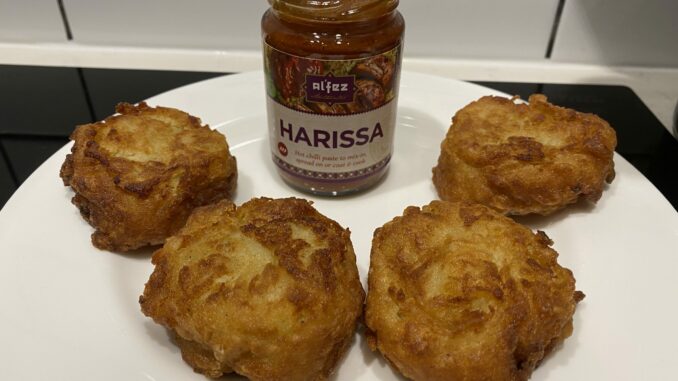
Introduction:
Nestled within the heart of Algerian cuisine, Maakouda emerges as a cherished culinary gem, embodying the essence of local flavors and cultural traditions. This extensive exploration embarks on a journey through the history, cultural significance, and the meticulous process of crafting the perfect Maakouda – a delightful Algerian dish that holds a special place in the hearts and palates of those who savor its golden, crispy goodness.
Part 1: Roots in Algerian Tradition
A. Origin and Heritage
Maakouda, sometimes referred to as “Maakouda Batata,” traces its roots deep into Algerian culinary tradition. The dish has become an integral part of Algerian street food culture, family gatherings, and festive occasions, symbolizing the resourcefulness and creativity of Algerian cooks.
B. Influence of Berber and Mediterranean Cuisine
Algerian cuisine, like many North African cuisines, reflects a rich blend of influences from Berber, Arab, Ottoman, and French culinary traditions. Maakouda, with its simplicity and versatility, epitomizes the fusion of these diverse culinary influences into a unique Algerian dish.
Part 2: Maakouda’s Culinary Evolution
A. Early Techniques and Ingredients
The early variations of Maakouda likely originated from the use of locally available ingredients, with a focus on potatoes as a primary element. Potatoes, introduced to North Africa during the colonial era, became a staple in Algerian households and subsequently found their way into traditional dishes like Maakouda.
B. Adaptability and Regional Variations
As with many traditional dishes, Maakouda has undergone regional variations and personal adaptations. Some regions may add herbs, spices, or additional ingredients to impart unique flavors, creating a delightful array of Maakouda interpretations throughout Algeria.
Part 3: Essential Ingredients and Flavor Harmony
A. Core Components
- Potatoes:
- Boiled and mashed potatoes serve as the base, contributing to the dish’s texture and heartiness.
- Onions:
- Finely chopped onions add a savory element, enhancing the overall flavor profile.
- Garlic:
- Minced garlic infuses the Maakouda with aromatic depth, creating a harmonious blend.
- Herbs and Spices:
- Parsley, coriander, cumin, and paprika contribute to the distinctive flavor bouquet.
- Eggs:
- Eggs bind the mixture, providing structure to the Maakouda.
B. Flavor Symphony
Maakouda weaves a flavor symphony where the earthy richness of potatoes meets the savory notes of onions and the aromatic infusion of garlic. Herbs and spices elevate the dish, introducing a burst of freshness and complexity. The eggs serve as the binding agent, unifying these elements into a cohesive and delectable whole.
Part 4: Crafting the Perfect Maakouda
A. Traditional Preparation
- Boiling and Mashing Potatoes:
- Boil potatoes until tender, then mash them into a smooth consistency.
- Sautéing Onions and Garlic:
- Sauté finely chopped onions and minced garlic until golden brown, infusing the mixture with savory aromas.
- Herbs and Spices:
- Add chopped parsley, coriander, cumin, and paprika for a burst of freshness and depth.
- Binding with Eggs:
- Incorporate beaten eggs into the potato mixture, creating a cohesive and moldable texture.
- Forming Patties:
- Shape the mixture into patties, ready for frying to achieve a golden and crispy exterior.
- Pan-Frying to Perfection:
- Pan-fry the Maakouda patties until they attain a golden brown color, ensuring a delightful crunch.
B. Variations and Personal Touches
- Spicy Kick:
- Some variations introduce chili powder or hot peppers for those who enjoy a spicier Maakouda.
- Cheese Infusion:
- Grated cheese, such as feta or Parmesan, can be added to the mixture for an extra layer of richness.
- Vegetable Medley:
- Diced vegetables like bell peppers or zucchini may be included to enhance flavor and add a colorful touch.
Part 5: Serving Traditions and Culinary Harmony
A. Maakouda in Algerian Meals
Maakouda often takes center stage in Algerian meals, serving as a delicious side dish, snack, or appetizer. Its versatility allows it to complement various Algerian specialties, contributing to the diverse and flavorful nature of Algerian cuisine.
B. Dipping Sauces and Accompaniments
Maakouda pairs well with various dipping sauces, such as harissa or yogurt-based condiments. It is often served with bread or enjoyed on its own, allowing the crispy exterior and tender interior to shine.
Part 6: Conclusion
In conclusion, Maakouda stands as a testament to the vibrancy and richness of Algerian culinary heritage. Its journey from the humble kitchens of Algerian homes to becoming a beloved street food symbolizes the cultural significance and enduring appeal of this delightful dish. As you embark on the journey of crafting and savoring the perfect Maakouda, let the golden exterior and savory interior transport you to the bustling streets and warm kitchens of Algeria, where tradition, innovation, and the joy of sharing a flavorful meal come together in a celebration of Algerian culinary artistry.